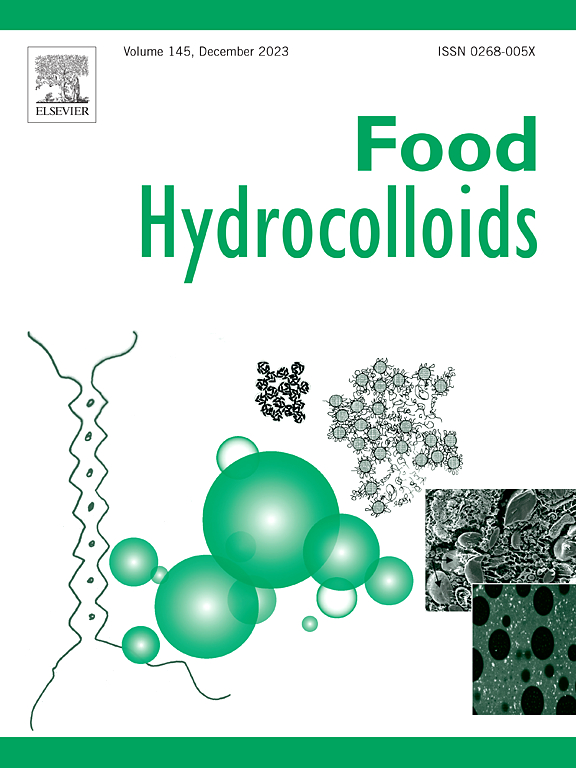Pectin emulsion gel: Effect of different low-methoxyl pectin on loading and colon-targeted release of curcumin
IF 11
1区 农林科学
Q1 CHEMISTRY, APPLIED
引用次数: 0
Abstract
High hydrostatic pressure-assisted enzymatic de-esterification of pectin (HHP-pectin) significantly enhanced the emul-gelling properties of low-methoxyl pectin (LMP). However, the effect of HHP-pectin-based emulsion gel on loading and controlled delivery has not been explored yet. In this study, emulsion gels of HHP-pectin were loaded with curcumin, and alkaline de-esterified LMP (A-pectin) with DM 5∼10 % was used as a control. It was found that curcumin was well encapsulated in LMP emulsion gel structure, and the encapsulation efficiency (EE) increased significantly, reaching 92.55 ± 2.19 %. At the same DM (5∼10 %), emulsion gel of HHP-pectin had more dense structure with uniform packing than that of A-pectin, that significantly improved light and thermal stability of curcumin, with retention rate of about 70.91 ± 1.07 % and 79.91 ± 2.35 % after 18 h of ultraviolet light treatment and 90 min of thermal treatment, respectively. LMP emulsion gels could significantly inhibit the release of curcumin in the oral, stomach, and small intestine, and at lower DM, it had a better-sustained release effect in the colon. At the same DM, HHP-pectin had a higher and sustained release of curcumin (89.03 ± 0.76 %) in the colon than A-pectin, mainly attributed to higher molecular weight (Mw) and viscosity of HHP-pectin. Thus, these results suggested that HHP significantly improved the potential of LMP emulsion gels as an effective carrier for colon-targeted delivery and its application in the food and drug industries.

求助全文
约1分钟内获得全文
求助全文
来源期刊

Food Hydrocolloids
工程技术-食品科技
CiteScore
19.90
自引率
14.00%
发文量
871
审稿时长
37 days
期刊介绍:
Food Hydrocolloids publishes original and innovative research focused on the characterization, functional properties, and applications of hydrocolloid materials used in food products. These hydrocolloids, defined as polysaccharides and proteins of commercial importance, are added to control aspects such as texture, stability, rheology, and sensory properties. The research's primary emphasis should be on the hydrocolloids themselves, with thorough descriptions of their source, nature, and physicochemical characteristics. Manuscripts are expected to clearly outline specific aims and objectives, include a fundamental discussion of research findings at the molecular level, and address the significance of the results. Studies on hydrocolloids in complex formulations should concentrate on their overall properties and mechanisms of action, while simple formulation development studies may not be considered for publication.
The main areas of interest are:
-Chemical and physicochemical characterisation
Thermal properties including glass transitions and conformational changes-
Rheological properties including viscosity, viscoelastic properties and gelation behaviour-
The influence on organoleptic properties-
Interfacial properties including stabilisation of dispersions, emulsions and foams-
Film forming properties with application to edible films and active packaging-
Encapsulation and controlled release of active compounds-
The influence on health including their role as dietary fibre-
Manipulation of hydrocolloid structure and functionality through chemical, biochemical and physical processes-
New hydrocolloids and hydrocolloid sources of commercial potential.
The Journal also publishes Review articles that provide an overview of the latest developments in topics of specific interest to researchers in this field of activity.
 求助内容:
求助内容: 应助结果提醒方式:
应助结果提醒方式:


